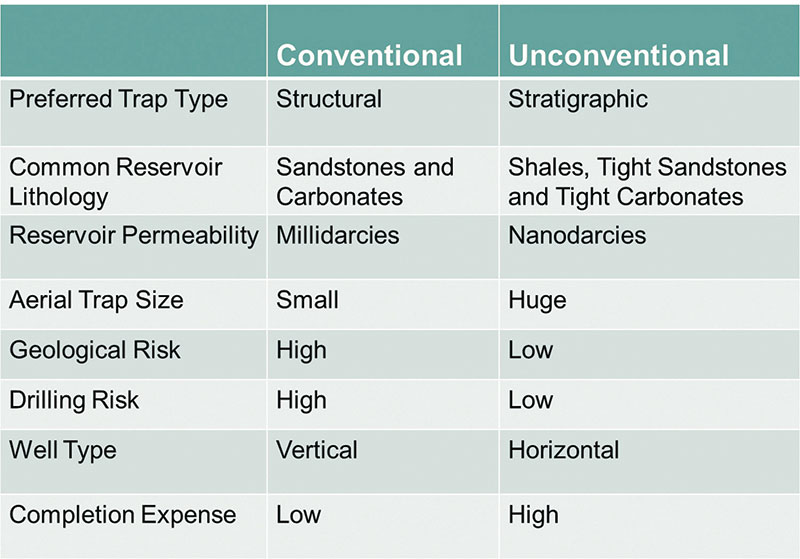
This table compares conventional exploration plays to unconventional plays.
“My concept of reservoirs has completely changed.”
I actually heard an engineer say these words – last summer, while attending a technical conference of geologists and engineers – and he was referring to the rapidly evolving concepts of reservoirs generated from shale gas reservoir research.
At the time it struck me that it was very unusual for an engineer to say this because, in my experience, engineers are sometimes more resistant to change than geologists.
Thinking of shales (or more correctly, mudstones) as reservoirs, however, is an example of a significant evolution of thinking – a progression also known as a paradigm shift.
For example, geologists of my generation learned that shales can act as source rocks when they contain abundant organic matter and as seals when they cover porous and permeable sandstones or carbonates.
Thinking of a shale as a reservoir, then, is a sometimes-difficult paradigm shift for geologists of my age.
Paradigm shifts occur from time to time – and, clearly, they can profoundly affect how petroleum geologists work. Exploring for gas shales, oily source rocks or tight oil reservoirs is profoundly different than exploring for more conventional reservoirs.
The accompanying table compares conventional exploration plays to unconventional plays – and as the table shows, exploring for shale gas, shale oil or tight oil reservoirs requires a different mindset.
Trap areas can cover many thousands of square miles or square kilometers; permeability is measured in nanodarcys – one billionth of a darcy – and the limit of permeability is determined by the size of the pore throats and the size of the molecules that can flow through them.
Not long ago, petroleum geologists were confronted by another non-geologic paradigm shift – using personal computers to manage and map geologic data. In the years since we first started using them, personal computers allowed petroleum geologists to be much more productive. One geologist now does what it used to require several geologists to do. Today, geologists work with more information and process it much more rapidly.
Some geologists, however, refused to make the transition to using computers to do geology. Those geologists are rare today and probably don’t work in larger companies! Using computers is not absolutely necessary but it is hard to imagine being competitive and surviving without them.
There are other examples: Sequence stratigraphy, for example, was a revolutionary method for interpreting patterns of strata caused by sea level fluctuation and basin tectonics. It created a prodigious lexicon of “seq-speak” – and inevitably left non-adopters in its wake.
To survive and prosper, geologists must evolve along with our science. We need to learn more about source rocks – for example, what is the relationship of pore creation to kerogen maturation.
The investigation of tight rocks is being achieved by technology we need to embrace: pulse decay perm, high resolution CT scanning and ion-milled samples with SEM imagery, for example.
We also need to learn more about completion technology, something that only engineers worried about in the not-too-distant past.
AAPG provides information to help you evolve and you should take advantage of that information. I suggest that during the coming year you consider:
- Attending an AAPG conference or a Geoscience Technology Workshop.
- Taking an AAPG school or online training course.
- Really reading the AAPG BULLETIN or the EXPLORER.
- Surfing Search and Discovery or AAPG Datapages.
Paradigm shifts require a response from us. We can refuse to learn about them and become extinct, or we can let our concepts and approaches evolve, allowing us to survive and thrive.
Editor's Note: Special thanks to AAPG member John McLeod, senior geologist for SM Energy Company in Tulsa, for his ideas and edits for this column.